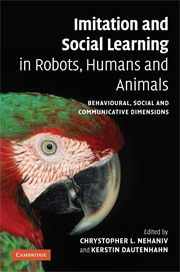 Imitation and Social Learning in Robots, Humans and Animals
Imitation and Social Learning in Robots, Humans and Animals Published online by Cambridge University Press: 10 December 2009
The evolutionary history and ecological context of matching behaviour of various types plays an important role in shaping its character. In this section, two chapters show radically contrasting types of matching in the animal kingdom.
In the first by Ludwig Huber, the capacity of a highly socially intelligent species, the kea (Nestor notabilis) for emulation learning of object affordances is demonstrated by a series of ingenious experiments on the behaviour of this playful and curious bird that has not only survived, but thrived despite the invasion of its homeland, New Zealand, by humans and other troublesome mammals. When human-reared, ‘enculturated’ keas may exhibit even more of a propensity toward social learning by observing others (see the discussions of Tomasello and Call (1997) on the effects of enculturation on primate cognition). Combining their social learning capacity together with individual learning in a successful reconciliation of social and technical cognition, keas have benefited from and continue to employ social learning and curiosity to drive their success in their particular changing ecological context.
This kind of socially intelligent learning is in sharp contrast to the type of matching surveyed by Mark D. Norman and Tom Tregenza in the final chapter of this book. Mimicry here is a form of deceptive resemblance (see Cott, 1940; Wickler, 1968; Hanlon and Messenger, 1998), which in invertebrates is a type of matching generally unlikely to involve much intelligence or learning within individuals, but whose genesis generally operates on evolutionary timescales in particular ecological contexts rather than within the lifetime of single individuals.
To save this book to your Kindle, first ensure no-reply@cambridge.org is added to your Approved Personal Document E-mail List under your Personal Document Settings on the Manage Your Content and Devices page of your Amazon account. Then enter the ‘name’ part of your Kindle email address below. Find out more about saving to your Kindle.
Note you can select to save to either the @free.kindle.com or @kindle.com variations. ‘@free.kindle.com’ emails are free but can only be saved to your device when it is connected to wi-fi. ‘@kindle.com’ emails can be delivered even when you are not connected to wi-fi, but note that service fees apply.
Find out more about the Kindle Personal Document Service.
To save content items to your account, please confirm that you agree to abide by our usage policies. If this is the first time you use this feature, you will be asked to authorise Cambridge Core to connect with your account. Find out more about saving content to Dropbox.
To save content items to your account, please confirm that you agree to abide by our usage policies. If this is the first time you use this feature, you will be asked to authorise Cambridge Core to connect with your account. Find out more about saving content to Google Drive.